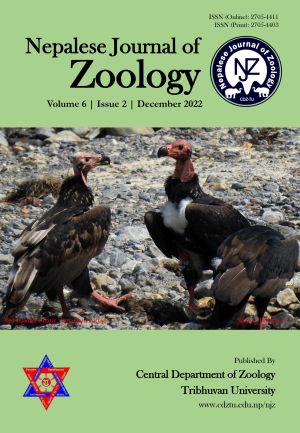Habitat use and diurnal activity budget of blue bulls (Boselaphus tragocamelus) in the Lumbini Heritage Site, Nepal
DOI:
https://doi.org/10.3126/njz.v6i2.51880Keywords:
Bovids; Focal animal sampling; Habitat use; Land cover; LumbiniAbstract
Blue bulls (Boselaphus tragocamelus) in Nepal are found near human settlements, crop fields and forest patches of lowland Terai and their management is becoming challenging due to conflicts with locals. This study explored habitat use and diurnal activity pattern of blue bulls at the Lumbini Heritage Site (LHS), one of the UNESCO World Heritage Sites from Nepal between 29 February and 31 March 2022. The habitat availability was quantified from classified land use land cover data of 10 m resolution and habitat use of the blue bulls was studied by direct observation. Activities of the blue bulls were recorded by the focal animal sampling method to determine the diurnal time budget for three observational phases 7:00–10:30 AM, 10:30–2:00 PM, and 2:00–5:30 PM; morning, afternoon and late-afternoon, respectively. The behavioral states recorded were grazing, locomotion, resting, alert and other activities (running, fighting, etc.). A total of 73 individuals of blue bulls were recorded along the 20 line transects each of 200–300 m in length. The majority of the blue bull individuals (52.05%) were observed in grassland that occupied only 7.14% of the LHS while lesser were found in dense forests (44.44% of the LHS) and agricultural land. Blue bulls spent the majority of their diurnal time on feeding followed by resting and locomotion. Feeding peaked during the morning and late-afternoon observational phases when the temperature was low whereas resting was the major activity in the afternoon. Because the grasslands are the most used habitats by blue bulls in the LHS, especially for feeding, we emphasize the proper management of the grasslands.
Downloads
Downloads
Published
How to Cite
Issue
Section
License
Copyright (c) 2022 Priyanka Pandey, Naresh Pandey, Laxman Khanal

This work is licensed under a Creative Commons Attribution-NonCommercial 4.0 International License.
This license enables reusers to distribute, remix, adapt, and build upon the material in any medium or format for noncommercial purposes only, and only so long as attribution is given to the creator.

